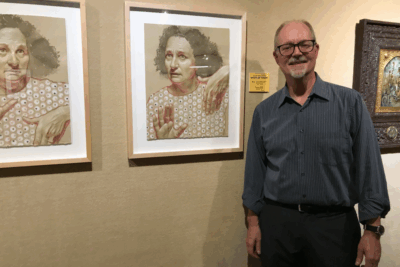More than 90% of Goshen College students are registered to vote in the 2020 presidential election and an overwhelming majority of those students are pledging to cast their ballots for the Democratic candidate and former vice president, Joseph R. Biden Jr., according to a survey administered to GC students who are eligible to vote.
The survey found 82% of respondents planning to vote for Biden and 11% for the Republican incumbent, President Donald Trump. About 7% of students said they were undecided, uninterested in voting or opting for another candidate.
“A thriving democracy depends on voter turnout,” President Rebecca Stoltzfus said. “The extraordinarily high intention to vote amongst our students is very encouraging.”
The survey was sent out on Oct. 6 to all GC students who were eligible to vote. Out of the 767 students who received the survey, 260 had responded by Oct. 10, for a 34% response rate.
The vast majority of students who took the survey, 96%, said they were registered to vote, a sign of mounting political engagement.
Voter registration among Goshen College students stood at 72.1% in 2014 and climbed to 83% in 2018.
In the survey, only 10 students said they were not yet registered to vote, and one person was unsure of their registration status.
According to the Campus Vote Project, Millennials and Gen Z make up the largest sector of eligible voters.
In 2014, it was adults ages 18-29 that made up 21% of eligible voters. However, this group which includes many traditional college students has not had that same presence in the actual electorate due to low voter turnout.
Many of the current trends we see at Goshen and other higher education institutions began in 2016 when more students were going to the polls.
Compared with the 2012 presidential election, student voting rose 9.1 points to 61.5%. White female undergraduates and multiracial students led the surge in new voters.
But the boom in student voting wasn’t over yet.
Even though midterm voting rates are historically lower than presidential election rates, the 2018 midterms saw a comparative rise in student voting.
From 2014 to 2018, the national average among higher education institutions rose from 19.7% to 39.1%.
At GC, midterm voter participation was even higher than the national average.
Between 2014 and 2018, the student rate at GC went up 27.7 points from 14.6% to 42.3%. Registration had also increased, with 80.3% of Goshen students registered to vote compared to 72.1% in 2014.
While in-person voting was in decline, the number of Goshen College students voting absentee was over seven times greater than in 2014.
Until election day, nothing can be said for sure about what these trends tell us. But registration rates, voting interest and which candidate students support provide some insight into what will happen in November.
Survey respondents were primarily upperclass students between the ages of 18 and 21. Almost twice as many women as men answered the survey, and the vast majority of students were white.
Only 17% of respondents were Latinx, which means that 32% of GC undergraduates who are Latinx were underrepresented in this study.
The vast majority of students who took the survey were registered to vote. The respondent registration rate rose from 83% of respondents in 2018 to 96%. Only 10 voters were not yet registered to vote, and one person was unsure of their registration status.
For the students who had not yet voted, the majority (30%) were unsure of how to register to vote.
Others expressed an active choice not to vote, with one student saying that not being registered to vote acted as an excuse to not vote in this election. “. . . even if I was registered I probably would not vote because I don’t want to be a part of this,” the student said.
85% of respondents said they were “extremely likely” to vote in the 2020 election.
As for issues on the ballot, COVID-19 and racial justice were ranked as particularly important. This is a shift from 2018 when education, immigration and climate change were at the top of students’ minds.
“There has been so much momentum in recent months and years for social revolution in terms of racial justice, women's rights, and policy change regarding the police,” commented one student. “I do not want to see it fizzle out.”
While a diversity of political perspectives were represented in this survey, there was a clear leaning toward Democratic politics among students as there has been in the past 10 years.
Still there has been growth in the number of students that identify as independents or as belonging to a third party group.
Although survey respondents were more likely to be voting in this year's election, Justin Heinzekehr, director of institutional research and assessment, said he is optimistic of the accuracy of results.
“It’s always possible that people who are engaged in this year's election are more likely to fill out this survey, but in comparing the 2018 voting rate with reported voting rates in this survey, we feel confident that we got a good cross-section of respondents,” he said.
Still, reflections from students show that this politically homogeneous environment may feel isolating for those with different party leanings.
“I'm a first-year college student engulfed in an environment with opinions that are completely different than mine,” one student wrote. “I just think that despite what I hear from others it’s pretty much impossible to change your own core beliefs.”
President Stoltzfus is aware of this reality as well.
“While the presidential preferences of GC students appear to be lopsided, I am sure that there is a great deal of variation in the motivations of students and the issues that matter most to them,” she said. “I hope that our campus can foster honest conversations about current political choices, conducted with open curiosity about each others' views.”

